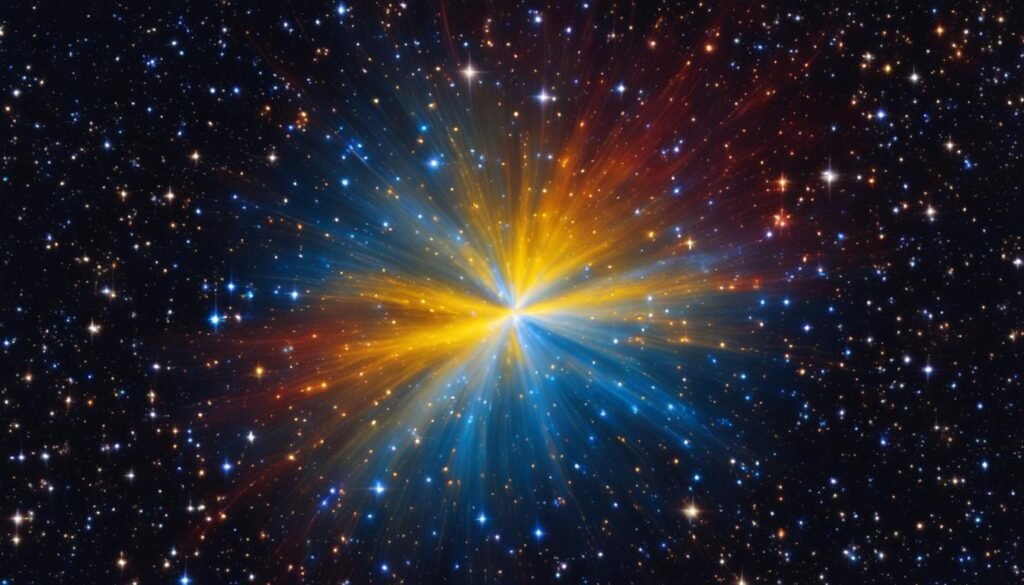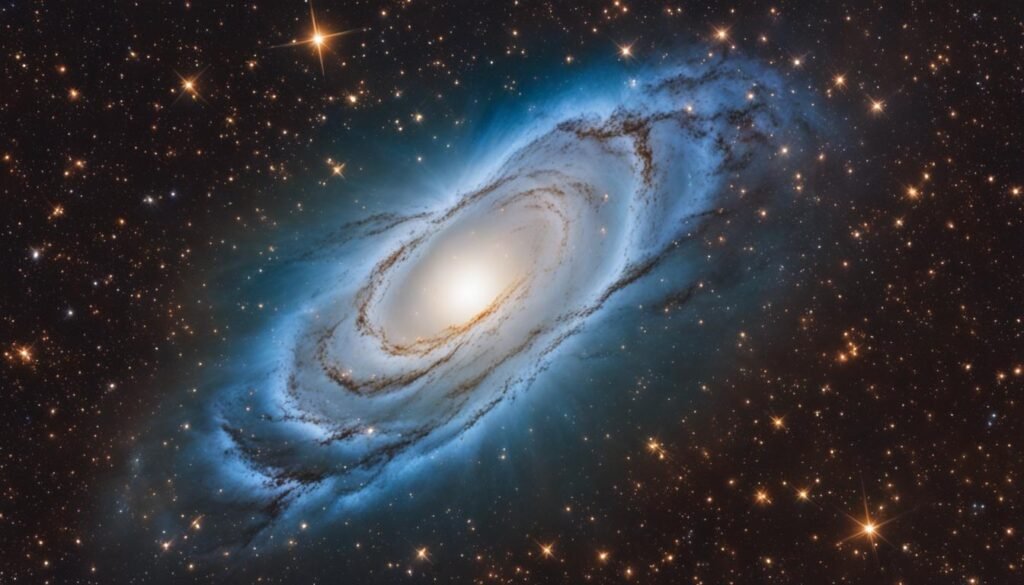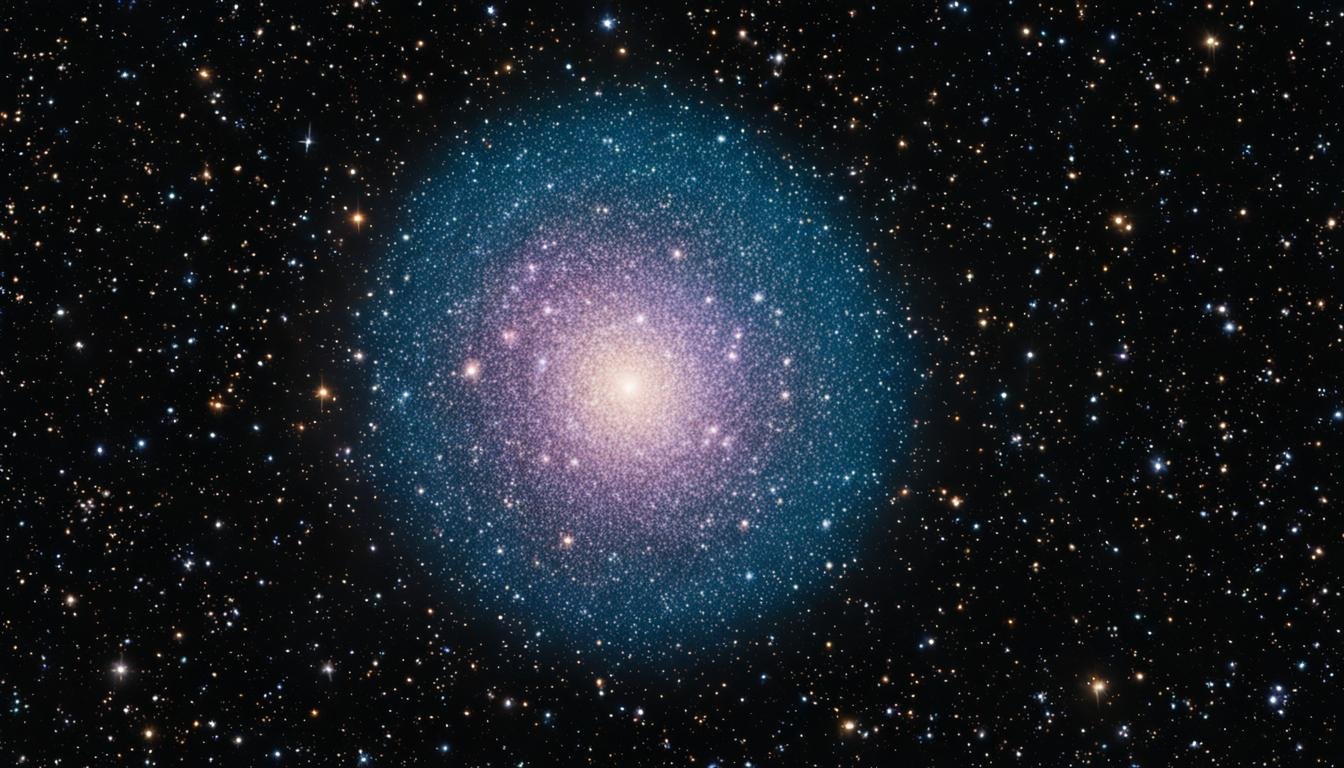Welcome to the captivating world of astronomy, where the wonders of the deep sky beckon. In this article, we invite you to explore Messier 28, a mesmerizing globular cluster nestled within the constellation Sagittarius. With its ethereal beauty and rich scientific significance, Messier 28 holds a special place in the hearts of astronomers and stargazers alike.
Discovered by Charles Messier in 1764, Messier 28, also known as NGC 6626, resides approximately 17,900 light years away from Earth. This deep sky object, with its faint yet alluring presence, has intrigued astronomers for centuries.
As you delve into the fascinating world of Messier 28, you will discover its remarkable features, ranging from its physical characteristics to its stellar content and pulsars. Join us as we uncover the wonders hidden within this celestial gem.
Key Takeaways:
- Messier 28 is a globular cluster located in the constellation Sagittarius.
- Discovered by Charles Messier in 1764, Messier 28 is approximately 17,900 light years away from Earth.
- With an apparent magnitude of 7.66, Messier 28 appears as a faint patch of light in the night sky.
- The cluster can be observed with binoculars, revealing a nebulous feature, and small telescopes provide a clearer view of its structure.
- Messier 28 has a combined mass of approximately 551,000 times that of the Sun and contains around 50,000 stars.
Location and Appearance of Messier 28
If you’re eager to explore the wonders of the night sky, the globular star cluster Messier 28 is a captivating celestial object worth observing. Located in the constellation Sagittarius, Messier 28 is relatively easy to spot. It is situated less than a degree northwest of Kaus Borealis, a brilliant star in Sagittarius.
While Messier 28 is not visible to the naked eye, it unveils its beauty when observed with binoculars. Through the lenses of binoculars, you’ll be able to perceive it as a faint patch of light amidst the surrounding stars.
For a more detailed view, opt for small telescopes. These instruments allow you to delve deeper into the cluster, unveiling a nebulous feature spanning approximately 11.2 arcminutes. With the aid of small telescopes, you can discern the intricate structure of Messier 28, revealing a stunning display of celestial wonders.
Physical Characteristics of Messier 28
Messier 28, also known as NGC 6626, is a captivating globular cluster with unique physical characteristics. Let’s explore its mass, diameter, age, and the presence of RR Lyrae variable stars.
Mass:
Messier 28 boasts a colossal combined mass of approximately 551,000 times that of the Sun. This immense mass contributes to the cluster’s gravitational pull, holding together its myriad of stars in a tight-knit formation.
Diameter:
Covering a vast expanse of 60 light years, Messier 28 showcases its grandeur with an impressive diameter. This expansive size allows for a multitude of stars to coexist within its celestial borders, forming a dense and captivating cluster.
Age:
With a lifespan of approximately 12 billion years, Messier 28 is considered ancient in astronomical terms. Its age predates the formation of our solar system and offers a glimpse into the early stages of the universe’s evolution.
RR Lyrae Variable Stars:
Messier 28 hosts a notable population of 18 RR Lyrae variable stars. These pulsating stars exhibit regular changes in brightness, making them invaluable tools for astronomers in measuring galactic distances. The presence of these variable stars within Messier 28 adds to its allure and scientific significance.
In the next section, we will delve into the stellar content and core of Messier 28, uncovering further intricacies of this remarkable globular cluster.
Stellar Content and Core of Messier 28
Messier 28, also known as NGC 6626, is not only home to a wide variety of stars, but it also possesses a dense and intriguing core. Within this globular cluster, you can find stars ranging in magnitude, with the brightest shining at a magnitude of 15. These encompass a stunning and captivating stellar landscape.
The cluster’s core covers an area of approximately 2 arc minutes in the sky. It displays an intermediate concentration of stars, creating a visually striking arrangement. The density of stars within the core, while slightly spread out, is nevertheless discernible, allowing for a fascinating observation of stellar density patterns.
To provide a comprehensive understanding of the stellar content and core of Messier 28, below is a table highlighting the details of the brightest stars and the overall stellar density within the cluster:
| Brightest Stars | Stellar Density |
|---|---|
| Magnitude 15 | Slightly spread out, but visible at the core region |
As displayed in the provided table, Messier 28 showcases a range of stellar magnitudes, with the brightest stars emanating a striking glow. Simultaneously, the core exhibits a captivating stellar density, inviting further investigation into the celestial wonders found within this globular cluster.
Pulsars in Messier 28
Messier 28, also known as NGC 6626, is not only a stunning globular cluster, but it is also home to a fascinating population of pulsars. The discovery of pulsars in this cluster has provided valuable insights into the nature of these enigmatic cosmic objects.
The first millisecond pulsar identified in Messier 28 was PSR B1821–24, discovered in 1986. This landmark finding opened up new opportunities for research and exploration within the cluster. Since then, astronomers have detected an additional 11 millisecond pulsars in Messier 28, making it one of the largest known populations of pulsars in a globular cluster.
Millisecond pulsars are highly magnetized rotating neutron stars that emit beams of electromagnetic radiation. They are characterized by their rapid spin rates, with periods ranging from just a few milliseconds to a few seconds. Studying these pulsars in Messier 28 allows astronomers to delve into the physics of extreme gravitational fields and gain a deeper understanding of the properties of these unique celestial objects.

Pulsars in Messier 28 Table
| Pulsar Name | Discovery Year |
|---|---|
| PSR B1821–24 | 1986 |
| PSR J1823−3021A | 2001 |
| PSR J1823−3021B | 2001 |
| PSR J1824−2452I | 2002 |
| PSR J1824−2452J | 2002 |
| PSR J1824−2452L | 2002 |
| PSR J1824−2452M | 2002 |
| PSR J1824−2452N | 2002 |
| PSR J1824−2452O | 2002 |
| PSR J1824−2452Q | 2002 |
| PSR J1824−2452R | 2002 |
| PSR J1824−2452S | 2002 |
The presence of these millisecond pulsars in Messier 28 provides astronomers with a unique opportunity to study the formation and evolution of these cosmic phenomena within the context of a globular cluster. The observations and research conducted within Messier 28 contribute to our broader understanding of the universe and the intricate processes that shape it.
Observations and Discoveries of Messier 28
Messier 28, initially mistaken for a nebula, was first observed by the renowned astronomer Charles Messier in 1764. However, it was not until the work of William Herschel in 1799 that the cluster was resolved into individual stars.
“Messier 28 is an excessively compressed globular cluster with stars of 14th to 15th magnitude,” noted John Herschel, son of William Herschel, during his further studies of the cluster.
This breakthrough observation by Charles Messier and the subsequent work by William Herschel and John Herschel have contributed significantly to our understanding of Messier 28’s unique nature and stellar composition.
Furthermore, these observations have sparked further research into the cluster’s properties and have paved the way for studies on the formation and evolution of globular clusters.
Messier 28 in Hubble Images
The Hubble Space Telescope, operated by the European Space Agency (ESA), has captured breathtaking images of Messier 28, revealing its jewel-like beauty and intricate structure. These stunning visuals provide a detailed view of the globular cluster, showcasing the individual stars within it and offering a fascinating glimpse into the wonders of the universe.

Through the meticulous processing by the European Space Agency, the true essence and magnificence of Messier 28 are beautifully portrayed in this image. The intricate patterns and vibrant colors of the stars highlight the celestial artistry embedded within this globular cluster.
By capturing such exquisite images of Messier 28, the European Space Agency continues to contribute to our understanding of the cosmos, enabling astronomers to delve deeper into the mysteries of the universe and unravel its secrets.
Messier 28 in the Messier Catalog
Messier 28, also known as NGC 6626, is a remarkable celestial object that has earned its place in Hubble’s prestigious Messier catalog. This catalog showcases a collection of stunning images of various celestial objects originally cataloged by Charles Messier, and Messier 28 holds its own among these captivating images.
Featured alongside other celestial wonders, the Hubble images of Messier 28 provide a unique glimpse into the diversity and beauty of the universe. These high-resolution images capture the intricate details of the globular cluster, revealing the dazzling array of stars within it.
From the awe-inspiring stellar density to the remarkable core, the Hubble images allow astronomers and enthusiasts alike to appreciate the celestial marvel that Messier 28 truly is. The catalog serves as a valuable resource for exploring celestial objects and bringing the wonders of the universe closer to home.
Messier 28 in Hubble’s Messier Catalog
| Object | Description |
|---|---|
| Messier 28 | A globular cluster located in the constellation Sagittarius |
| Location | Approximately 17,900 light years away from Earth |
| Hubble images | Revealing the beauty and intricacy of the globular cluster |
| Contribution | Provides valuable insights into the diversity and beauty of the universe |
The inclusion of Messier 28 in the Messier catalog signifies its importance and scientific significance. The powerful images captured by the Hubble Space Telescope, processed by the European Space Agency, highlight the breathtaking features of this celestial gem.
Messier 28’s place in the Messier catalog immortalizes its beauty and invites us to explore the wonders of the universe with awe and curiosity.
Significance and Scientific Research on Messier 28
Messier 28, also known as NGC 6626, holds great significance in the field of astronomical research. This globular cluster has been extensively studied, providing valuable insights into the study of globular clusters, variable stars, and pulsars.
The properties and stellar population of Messier 28 offer a window into the formation and evolution of galaxies. By analyzing the composition, mass, and age of the cluster, astronomers can gain a deeper understanding of the processes that shape the universe.
In particular, Messier 28 has enhanced our knowledge of globular clusters, which are ancient and tightly bound collections of stars. These clusters act as stellar laboratories, allowing scientists to study the interactions and dynamics of stars within dense environments.
Furthermore, Messier 28 hosts a significant number of variable stars, including 18 RR Lyrae variable stars. These stars exhibit regular changes in brightness, making them crucial for distance measurements in astronomy. By studying the behavior of variable stars in Messier 28, scientists can refine their understanding of stellar evolution and galactic distances.
One of the most exciting discoveries in Messier 28 is the presence of millisecond pulsars. These rapidly rotating neutron stars emit beams of electromagnetic radiation, providing astronomers with unique insights into extreme astrophysical phenomena. The study of pulsars in Messier 28 has contributed to our understanding of these enigmatic cosmic objects and their role in the universe.
“Messier 28 serves as a treasure trove of scientific data for astronomers. Through detailed observations and analysis, researchers can unlock the secrets of globular clusters, variable stars, and pulsars, unraveling the mysteries of the cosmos.”
Take a closer look at the scientific research surrounding Messier 28:
| Globular Clusters | Variable Stars | Pulsar Studies |
|---|---|---|
| Investigating their formation and evolution | Studying their behavior and implications for distance measurements | Exploring the properties and dynamics of millisecond pulsars |
| Examining their stellar populations and interactions | Contributing to our understanding of stellar evolution | Advancing our knowledge of extreme astrophysical phenomena |
| Unraveling the mysteries of densely packed star clusters | Refining galactic distance measurements | Shedding light on the role of pulsars in the universe |
Conclusion
Messier 28, a captivating globular cluster located in the constellation Sagittarius, offers astronomers a wealth of fascinating discoveries. With its dense core and diverse stellar population, Messier 28 serves as an extraordinary object of study in the field of astronomy. Through research and exploration of this celestial wonder, scientists have deepened their understanding of the universe and our place within it.
The intricate structure of Messier 28’s core, spanning 2 arc minutes, provides a glimpse into the formation and evolution of galaxies. Its combined mass of approximately 551,000 times that of the Sun and its age of 12 billion years reveal the cluster’s ancient nature and the wealth of knowledge it holds. This globular cluster is also home to 18 RR Lyrae variable stars, which astronomers use to measure galactic distances.
Moreover, Messier 28 has played a pivotal role in the discovery and study of millisecond pulsars. The initial detection of PSR B1821–24, the first millisecond pulsar in a globular cluster, in 1986 marked a milestone in pulsar research. Since then, an additional 11 millisecond pulsars have been identified in Messier 28, contributing to our understanding of these remarkable celestial objects.
Astronomical discoveries within Messier 28 continue to captivate scientists and deepen our understanding of the universe. As researchers delve further into the mysteries held within this globular cluster, they uncover insights that shape our knowledge of the cosmos. By exploring Messier 28 and other celestial treasures, we embark on an enriching journey that reveals the wonders of the universe and our place within it.
FAQ
What is Messier 28?
Messier 28, also known as NGC 6626, is a globular star cluster located in the constellation Sagittarius.
How far away is Messier 28?
Messier 28 is approximately 17,900 light years away from Earth.
How can I find Messier 28 in the night sky?
Messier 28 can be found less than a degree northwest of Kaus Borealis, a bright star in the constellation Sagittarius. It is best observed with binoculars or a small telescope.
What are the physical characteristics of Messier 28?
Messier 28 has a combined mass of approximately 551,000 times that of the Sun and a diameter of about 60 light years. It is estimated to be around 12 billion years old and contains an estimated 50,000 stars.
What is the stellar content and core of Messier 28 like?
Messier 28 contains a wide variety of stars, with the brightest stars having a magnitude of 15. Its dense core covers 2 arc minutes of the sky and displays an intermediate concentration of stars.
Are there any pulsars in Messier 28?
Yes, Messier 28 is home to 11 millisecond pulsars, making it the third-largest population of pulsars in a globular cluster. Pulsars are highly magnetized rotating neutron stars that emit beams of electromagnetic radiation.
Who discovered Messier 28?
Messier 28 was first observed by Charles Messier in 1764 and later resolved into individual stars by William Herschel in 1799. John Herschel further studied and described the cluster.
Are there any Hubble images of Messier 28?
Yes, the Hubble Space Telescope has captured stunning images of Messier 28, showcasing its beauty and intricate structure. These images have been processed by the European Space Agency (ESA).
Is Messier 28 included in the Messier catalog?
Yes, Messier 28 is included in Hubble’s Messier catalog, which features images of celestial objects from Charles Messier’s original catalog. The Hubble images of Messier 28 provide valuable insights into the diversity and beauty of the universe.
What is the significance of Messier 28 in scientific research?
Messier 28 plays a significant role in the study of globular clusters, variable stars, and pulsars. Its properties and stellar population provide valuable insights into the formation and evolution of galaxies. The discovery of millisecond pulsars in Messier 28 has contributed to the understanding of these fascinating celestial objects.
What can we learn from exploring Messier 28?
By exploring Messier 28, astronomers can continue to unravel the mysteries of the universe and gain a deeper understanding of our place within it. The cluster’s dense core, diverse stellar population, and significant scientific discoveries make it a fascinating object of study.






